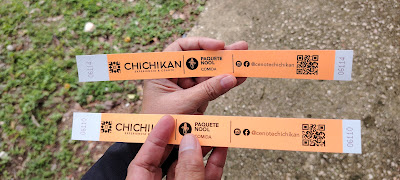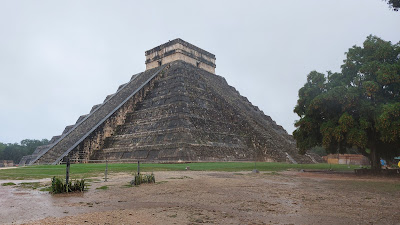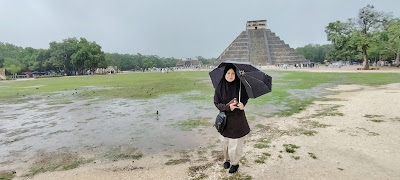"I love those days when my only decision is whether to go to the beach in the morning or afternoon..."
 |
| (Chichen Itza, Mexico - One of the 7 Wonders of the World) |
Day 09: 27/06/25 (Friday)
Activity: Valladolid, Cenote and Chichen Itza Day Trip
Hotel: Ibis Hotel Cancun Centro Mexico
We had a heavy breakfast at Ibis Kitchen Lounge before beginning the tour for Valladolid, Cenote and Chichén-Itza.
 |
| (Ibis Kitchen Lounge) |
 |
| (A heavy breakfast to last till noon) |
We took an Uber to the pick up point at Oasis Hotel. We will be joining a bus full of tourists for the full day Chichén-Itzá Tour by Amigo Tour. On the bus, Mr. Jonathan a.k.a. Johny Cash, our tour guide explained about the Mayan history, alphabets and numbers.
 |
| (The highway passes through virgin jungle) |
 |
| (The railway is running parallel to the highway) |
 |
| (A junction to Valladolid Town centre) |
Our first stop was the Valladolid Town Centre. The city was founded on May 28, 1543, by Francisco de Montejo. It was originally located in the Mayan town of Chauac-Há. In March 24, 1545, the town was moved to Zací, the capital of the Mayan chiefdom of the Cupules. In 1848, the city and its haciendas were taken by the indigenous Mayans during the Caste War in response to the oppression they suffered at the hands of the Yucatecan government, so the affected families had to emigrate to other regions.
 |
| (The main square of the town) |
 |
| (A Mayan lady at the fountain) |
 |
| (Also known as the Park of Lovers) |
The city was taken months later by the Yucatecan government after the agreement for the federal government to provide them with weapons and troops in exchange for abandoning the idea of separating from the Republic. In June 4, 1910, the city was the scene of one of the first antecedents of the Mexican Revolution known as the Valladolid Rebellion or the First Spark of the Revolution.
 |
| ( A hop on hop off bus of Valladolid) |
 |
| (The colourful buildings of Valladolid) |
 |
| (Church of San Servatius) |
Our second stop was at Chichikan Cultural and Ecological Park in Valladolid, Yucatán, Mexico, offering an immersive experience into Mayan culture. It features a cenote for swimming and recreations of Mayan village life and opportunities to learn about Mayan traditions, including rituals and ceremonies.
 |
| (The wrist bands for the visitors) |
 |
(A slippery wet path after the heavy rain)
|
 |
| (The oasis cenote of the Mayan) |
 |
| (Beautifully woven bamboo. The entrance to the Cenote) |
 |
| (The bamboo tunnel leading to the pool) |
 |
| (Inside the bamboo tunnel) |
.jpg) |
| (A slippery stairs to the Cenote) |
 |
| (The view of the Cenote from the upper deck) |
 |
| (A natural sink hole) |
 |
| (Watching from above the sinkhole. The inside is lighted up) |
 |
| (Clear fresh water underground swimming pool) |
We had our Cenote lunch at the "Nool" Restaurant at Chichikan, which serves regional buffet-style Mayan cuisine, offering a taste of local flavours in a natural setting. We had the vegetarian lunch from the buffet spread. Later we visited the souvenir shops which display and sell varieties of vibrant coloured local handicrafts.
 |
| (Signages to the attractions) |
 |
| (Having lunch under the canopy) |
 |
| (Serene and tranquility in the forest) |
 |
| (Celebratory reminder of life and death) |
 |
| (Mexican folk arts bamboo paintings) |
 |
| (Back in the hotel by 9.00 pm) |

























.jpg)






























No comments:
Post a Comment